
I am an Assistant Professor in the Department of Economics at Arizona State University and a Research Economist at the National Bureau of Economic Research.
I work on various topics in economic theory including mechanism design and repeated games. I also study public finance with a focus on optimal taxation.
Working Papers

Accepted at Econometrica
Uncertain repeated games
Multiple long run players play one amongst multiple
possible stage games in each period. They observe and recall past play and are aware
of the current stage game being played, but are uncertain about the future evolution
of stage games. This setup is termed an uncertain repeated game. The solution
concept requires that a subgame perfect equilibrium be played no matter what
sequence of stage games realize. The feasible set of payoffs is then so large and
complex that it is not obvious how to frame standard results such as the folk
theorem, and further how to construct credible rewards and punishments that work
irrespective of the future evolution of games. The main goal of the paper is to
build such a language through two different perspectives— one in which the modeler
has access to the true stochastic process but not the players and another in which
there is simply maximal uncertainty; and then to construct credible dynamic
incentives that work generally for uncertain repeated games. A complete
characterization of equilibria is presented for large discount factors and various
extensions to related models and results are discussed in detail.
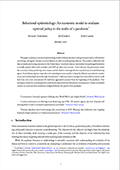
Accepted at Quarterly Journal of Economics
The Optimal Taxation of Couples
We consider optimal joint nonlinear earnings taxation
of couples. We use multi-dimensional mechanism design techniques to study this
problem and show that the first-order approach – that restricts attention to only
local incentive constraints – is valid for a broad set of primitives. Optimal taxes
are characterized by the solution to a certain second-order partial differential
equation. Using the Coarea Formula, we solve this equation for various conditional
averages of optimal tax rates and identify key forces that determine the optimal tax
rates; show how these rates depend on earnings of each spouse, correlation in
spousal earnings, and redistributive objectives of the planner; compare optimal
rates for primary and secondary earners; identify both the conditions under which
simple tax systems are optimal and the sources of welfare gains from more
sophisticated taxes when those conditions are not satisfied. Optimal tax rates for
married individuals are increasing in correlation of spousal earnings but are lower
than the tax rates for single individuals, and the marginal rates for one spouse
increase (decrease) in the earnings of the other when both spouses have low (high)
earnings.
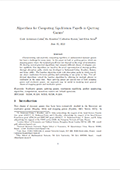
The APS Approach for Undiscounted Quitting Games
Characterizing and explicitly computing equilibria of
undiscounted dynamic games have been a challenge for many years. In this paper, we
study quitting games, which are stopping games where the terminal payoff does not
depend on the stage of termination. We adapt the recursive approach of Abreu,
Pearce, and Staccheti (1990) to characterize a certain subset of the set of
subgame-perfect ε-equilibrium payoffs. Our approach is based on the novel
representation of strategy profiles through absorption paths, which was developed in
Ashkenazi-Golan, Krasikov, Rainer, and Solan (2023), and our characterization
focuses on absorption paths in which exactly one player randomizes between quitting
and continuing at any point in time. We then adapt the results to larger classes of
absorption paths. Since quitting games form a special case of both stopping games
and stochastic games, our approach may be useful in studying more general classes of
these games
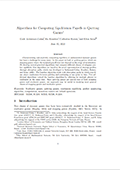
Hard Information Design
Many transactions in the marketplace rely on hard (or
verifiable) information about the underlying value of the intended exchange,
typically through certification— housing, diamonds, bonds being cases in point. What
is the class of Pareto efficient certifications for such scenarios? This paper
studies the canonical monopolistic screening problem, and models certification as
hard information produced through a test to be flexibly chosen pre-trade. It argues
that Pareto efficient tests take a simple form—they produce certification with a
partitional structure, often with one or two thresholds. This claim is shown to be
true for both the linear trading model and the non-linear pricing model.

Behavioral epidemiology: An economic model to evaluate optimal policy in the midst of a pandemic
This paper combines a canonical epidemiology model of
disease dynamics with government policy of lockdown and testing, and agents’
decision to social distance in order to avoid getting infected. The model is
calibrated with data on deaths and testing outcomes in the Unites States. It is
shown that an intermediate but prolonged lockdown is socially optimal when both
mortality and GDP are taken into account. This is because the government wants the
economy to keep producing some output and the slack in reducing infection is picked
up by social distancing agents. Social distancing best responds to the optimal
government policy to keep the effective reproductive number at one and avoid
multiple waves through the pandemic. Calibration shows testing to have been
effective, but it could have been even more instrumental if it had been aggressively
pursued from the beginning of the pandemic. Not having any lockdown or shutting down
social distancing would have had extreme consequences. Greater centralized control
on social activities would have mitigated further the spread of the pandemic.
Publications
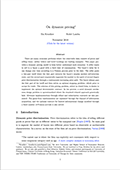
American Economic Journal: Microeconomics
On Dynamic Pricing
There are many economic problems where the observable
data consists of prices and selling times– airline tickets and hotel bookings are
leading examples. This paper pro- vides a dynamic pricing model to help better
understand such scenarios: A seller wants to sell to a buyer a good with a fixed
date of consumption. The buyer’s value for it can change over time according to a
Poisson process prior to the date. The seller posts a two-part tariff where the
first part extracts the buyer’s surplus modulo self-selection rents, and the second
part sequentially segments the market in the spirit of second degree price
discrimination through a continuously increasing price path. The buyer always pays
the first part of the tariff and then solves an optimal stopping problem– which
price to accept for trade. The solution of this pricing problem, solved in closed
form, is shown to implement the optimal deterministic contract. In the process, a
novel dynamic mecha- nism design problem is operationalized where the standard
relaxed approach generically fails. Alternate implementations through refund and
subscription contracts are also pre- sented. The gains from randomization are
explained through the channel of information acquisition, and the optimal contract
for limited informational change modeled through a fixed number of Poisson arrivals
is also solved.

Journal of Economic Theory
A Theory of Dynamic Contracting with Financial Constraints
Financial constraints preclude many surplus producing
economic transactions, and inhibit the growth of many others. This paper models
financial constraints as the interaction of two forces: the agent has persistent
private information and is strapped for cash. The wedge between the optimal and
efficient allocation, termed distortion, increases over time with each successive
“bad shock” and decreases with each “good shock”. At any point in the contract, an
endogenous number of “good shocks” are required for the principal to provide some
liquidity and then eventually for the contract to become efficient. Efficiency is
reached almost surely. The average rate at which contract becomes efficient is
decreasing in persistence of shocks; in particular, the iid model predicts a quick
dissolution of financial constraints. This speaks to the relevance of modeling
persistence in dynamic models of agency. The problem is solved recursively, and
building on the literature, a technical tool of finding the minimal subset of the
recursive domain that houses the optimal contract is further developed.

American Economic Journal: Microeconomics
Implications of unequal discounting in dynamic contracting
Dynamic contracts typically allow the principal to
relax future incentive constraints by backloading the agent’s information rents or
asking the agent to post a bond upfront which is liquidated over time. An implicit
modeling assumption at play there is that both the principal and agent have equal
access to capital, captured by equal discount rates. This paper introduces unequal
discounting in a canonical dynamic screening problem where the agent has Markovian
private information and limited commitment. The backloading force is tempered by an
inter-temporal cost of incentive provision. The optimal contract features cycles
with infinite memory. The interaction of Marokvian information and unequal
discounting introduces technical challenges by rendering the standard relaxed
problem approach invalid for certain parameters. An approximately optimal and simple
alternative is provided, where both terms are made formalized.
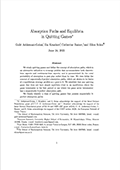
Mathematical Programming Series B
Absorption Paths and Equilibria in Quitting Games
We study quitting games and define the concept of
absorption paths, which is an alternative definition to strategy profiles that
accommodates both discrete- time aspects and continuous-time aspects, and is
parametrized by the total probability of absorption in past play rather than by
time. We then define the concept of sequentially 0-perfect absorption paths, which
are shown to be limits of ε-equilibrium strategy profiles as ε goes to 0. We
establish that any quitting game that does not have simple equilibria (that is, an
equilibrium where the game terminates in the first period or one where the game
never terminates) has a sequentially 0-perfect absorption path. We finally identify
a class of quitting games that possess sequentially 0- perfect absorption paths